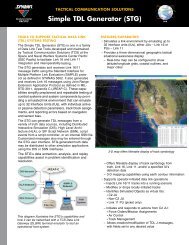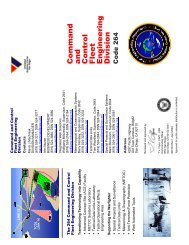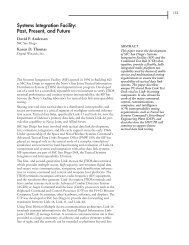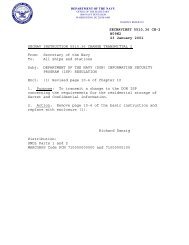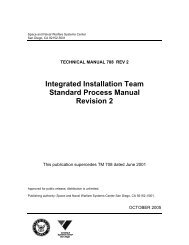Intelligence, Surveillance, and Reconnaissance - Spawar
Intelligence, Surveillance, and Reconnaissance - Spawar
Intelligence, Surveillance, and Reconnaissance - Spawar
You also want an ePaper? Increase the reach of your titles
YUMPU automatically turns print PDFs into web optimized ePapers that Google loves.
170<br />
INTELLIGENCE, SURVEILLANCE, AND RECONNAISSANCE<br />
1<br />
where f i = is the output of the i th hidden node, x i is the<br />
1 + exp(–x i)<br />
dot product sum of the previous input layer’s output with the connecting<br />
weights of the hidden layer, NN m is the m th output of the neural network,<br />
w im is the m th output weight connected to the i th hidden node, w ki<br />
is the k th input weight connected to the i th hidden node, <strong>and</strong> I k is the k th<br />
input feeding the neural network.<br />
Neural Extended Kalman Filter<br />
The NEKF developed by Stubberud [1] is based on the Singhal <strong>and</strong> Wu<br />
EKF neural-network trainer. The algorithm uses a Kalman filter to estimate<br />
the states by using a linear system model <strong>and</strong>, at the same time,<br />
using the Kalman filter to train a neural network to calculate the nonlinearities,<br />
mismodeled dynamics, higher order modes, <strong>and</strong> other facets of a<br />
system. Estimation of the system states is performed at once without the<br />
necessity of modeling the nonlinearities a priori as in the case of the<br />
extended Kalman filter. The inputs to the neural network are the updated<br />
states of the filter. The inputs are passed through an input layer, a hidden<br />
layer with nonlinear squashing functions, <strong>and</strong> an output layer. The outputs<br />
of the neural network are nonlinear corrections to the linear predicted<br />
state of the underlying Kalman filter.<br />
NEKF IMM ALGORITHM<br />
The NEKF IMM algorithm was developed under this ILIR project.<br />
The IMM architecture allows for Kalman-filter models of different state<br />
dimensions to be mixed together appropriately. In order to mix the<br />
NEKF’s state vector <strong>and</strong> covariance matrix with the other two linear<br />
Kalman-filter models, care had to be taken. To keep a positive definite<br />
covariance matrix of the neural-network model, the mixing probability<br />
of the interacting multiple-model architecture had to be applied to the<br />
artificial-neural-network weights <strong>and</strong> covariance matrix. At first glance,<br />
it was not obvious to weight probabilistically the weight vector <strong>and</strong><br />
weight covariance matrix of the NEKF by the mode probability. Once<br />
the probability weighting was incorporated <strong>and</strong> had stabilized the neuralnetwork<br />
covariance matrix, a different sigmoid squashing function had<br />
to be implemented. By weighting the neural network with its mixing probability,<br />
the weight vector tended toward zero, which caused the weights<br />
to be untrainable. What caused the weights to be untrainable was using a<br />
hyperbolic tangent function as a sigmoid-squashing function that varied<br />
from [–1, 1]. A new sigmoid varying from [0, 1] allowed for a derivative<br />
of 0.5 if the weights of the neural network were equal to 0.0. This allowed<br />
the weights to be trainable if they were initialized to zero or tended<br />
toward zero. Once this was incorporated, the neural network was able<br />
to be trained inside an IMM architecture.<br />
RESULTS<br />
The scenario consisted of a single target moving in a circular motion for<br />
500 seconds. The speed of the target was 50 meters per second, <strong>and</strong> the<br />
angular rate of the turn was –10 degrees per second. The sampling rate of<br />
the radar was one sample per second. There were 500 samples for each<br />
Monte Carlo run. Figures 1 through 5 <strong>and</strong> Table 1 are the 100 Monte



